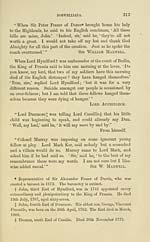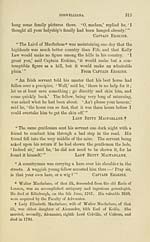Grampian Club > Boswelliana
(348) Page 314
Download files
Complete book:
Individual page:
Thumbnail gallery: Grid view | List view

314 BOSWELLIANA.
" A fellow was swearing most terribly in a coffee-house.
Colonel ForresterJ came up to him, ' Pray sir,' what entitles
you to swear and blaspheme at this rate ? ' Eh, colonel,' said
he, ' What ! are you reproving me for it ? I'm sure you used to
swear as much as any man.' 'Yes sir,' said he, 'when it was
the fashion. But now it is only practised by porters and
chairmen. I left it off as below a gentleman.' "
Me. Goldie, of Hoddam.
" Cosmo Alexander* the painter, upon a slight acquaintance
with a Eoman Catholic lady, took her out to dance in the Edin-
burgh assembly, and as he was figuring away in black velvet
with various gesticulations, ' Lord Elibank,' asked Sir William
Maxwell, ' who's that who dances ? ' Being told Mr. Alexander
the painter, ' Upon my word,' said his lordship, ' a very pic-
turesque minuet.' " Sir William Maxwell.
" The Duke of Newcastle f had a very mixed character, was not
deficient in parts, but was remarkable for being inattentive,
confused, and hurried. Lord Cliesterfield said he was like a
man who had lost half an hour in the morning, and was running
about all the day, in order to find it again." Lord Kames.
"Lady , a woman of low birth, whose father and uncle had
both been strung at Tyburn, asked George Selwyn| to come
and see an elegant room which she was fitting up at her house
in Pall Mall. George, observing some vacant places for pictures,
inquired what she was to put there. She said she intended to
* Probably a brother of John Alexander, the celebrated painter.
John x4.1exander studied his art chiefly in Florence ; he returned to
Scotland in 1720, and thereafter chiefly resided in Gordon Castle,
under the patronage of the Duchess of Gordon.
t Henry, second Duke of !N"ewcastle. His Grace died in 1794.
X George Selwyn, M.P., the celebrated humorist, was born in
1719, and died 25th January, 1791. ("Sir George Selwyn and his
Contemporaries," by J. H. Pope, 1843.)
" A fellow was swearing most terribly in a coffee-house.
Colonel ForresterJ came up to him, ' Pray sir,' what entitles
you to swear and blaspheme at this rate ? ' Eh, colonel,' said
he, ' What ! are you reproving me for it ? I'm sure you used to
swear as much as any man.' 'Yes sir,' said he, 'when it was
the fashion. But now it is only practised by porters and
chairmen. I left it off as below a gentleman.' "
Me. Goldie, of Hoddam.
" Cosmo Alexander* the painter, upon a slight acquaintance
with a Eoman Catholic lady, took her out to dance in the Edin-
burgh assembly, and as he was figuring away in black velvet
with various gesticulations, ' Lord Elibank,' asked Sir William
Maxwell, ' who's that who dances ? ' Being told Mr. Alexander
the painter, ' Upon my word,' said his lordship, ' a very pic-
turesque minuet.' " Sir William Maxwell.
" The Duke of Newcastle f had a very mixed character, was not
deficient in parts, but was remarkable for being inattentive,
confused, and hurried. Lord Cliesterfield said he was like a
man who had lost half an hour in the morning, and was running
about all the day, in order to find it again." Lord Kames.
"Lady , a woman of low birth, whose father and uncle had
both been strung at Tyburn, asked George Selwyn| to come
and see an elegant room which she was fitting up at her house
in Pall Mall. George, observing some vacant places for pictures,
inquired what she was to put there. She said she intended to
* Probably a brother of John Alexander, the celebrated painter.
John x4.1exander studied his art chiefly in Florence ; he returned to
Scotland in 1720, and thereafter chiefly resided in Gordon Castle,
under the patronage of the Duchess of Gordon.
t Henry, second Duke of !N"ewcastle. His Grace died in 1794.
X George Selwyn, M.P., the celebrated humorist, was born in
1719, and died 25th January, 1791. ("Sir George Selwyn and his
Contemporaries," by J. H. Pope, 1843.)
Set display mode to: Large image | Transcription
Images and transcriptions on this page, including medium image downloads, may be used under the Creative Commons Attribution 4.0 International Licence unless otherwise stated. ![]()
| Publications by Scottish clubs > Grampian Club > Boswelliana > (348) Page 314 |
|---|
| Permanent URL | https://digital.nls.uk/82555580 |
|---|
| Description | Note: Numbers 24-41 are relative to but not part of the Club's series. |
|---|---|

